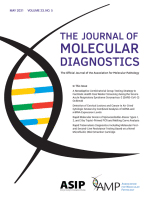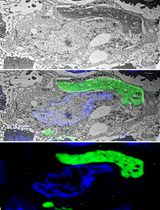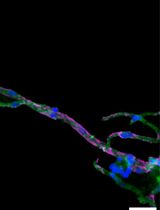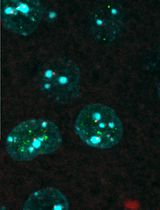- EN - English
- CN - 中文
Triplet-primed PCR and Melting Curve Analysis for Rapid Molecular Screening of Spinocerebellar Ataxia Types 1, 2, and 3
三引物PCR和熔解曲线分析用于快速分子筛选1型、2型和3型脊髓角共济失调
发布: 2023年06月20日第13卷第12期 DOI: 10.21769/BioProtoc.4704 浏览次数: 1171
评审: Alessandro DidonnaEsteban Paredes-OssesNeha NandwaniAnonymous reviewer(s)
Abstract
There are more than 40 types of spinocerebellar ataxia (SCA), most of which are caused by abnormal expansion of short tandem repeats at various gene loci. These phenotypically similar disorders require molecular testing at multiple loci by fluorescent PCR and capillary electrophoresis to identify the causative repeat expansion. We describe a simple strategy to screen for the more common SCA1, SCA2, and SCA3 by rapidly detecting the abnormal CAG repeat expansion at the ATXN1, ATXN2, and ATXN3 loci using melting curve analysis of triplet-primed PCR products. Each of the three separate assays employs a plasmid DNA carrying a known repeat size to generate a threshold melt peak temperature, which effectively distinguishes expansion-positive samples from those without a repeat expansion. Samples that are screened positive based on their melt peak profiles are subjected to capillary electrophoresis for repeat sizing and genotype confirmation. These screening assays are robust and provide accurate detection of the repeat expansion while eliminating the need for fluorescent PCR and capillary electrophoresis for every sample.
Keywords: Spinocerebellar ataxia (脊髓小脑性共济失调)Background
The autosomal dominantly inherited spinocerebellar ataxias (SCAs) are neurodegenerative diseases that mainly cause progressive degeneration of the cerebellum and, sometimes, the spinal cord (Klockgether et al., 2019). There are more than 40 types of SCA, which can be caused by deletions, missense variants, and repeat expansion in different genes (Klockgether et al., 2019). The SCAs have an average prevalence of 2.7/100,000 globally, with SCA3 being the most common, followed by SCA2, SCA6, and SCA1 (Hersheson et al., 2012; Ruano et al., 2014). SCA1, SCA2, and SCA3 are caused by large abnormal CAG trinucleotide repeat expansions in ATXN1, ATXN2, and ATXN3 genes, respectively (Chung et al., 1993; Orr et al., 1993; Kawaguchi et al., 1994; Pulst et al., 1996).
Molecular genetic testing is necessary to identify the causative gene underlying the SCA. Detection of repeat expansions in SCA1, SCA2, and SCA3 has been accomplished using standard PCR or triplet-primed PCR (TP-PCR), followed by capillary electrophoresis (Dorschner et al., 2002; Cagnoli et al., 2006; Melo et al., 2016; Cagnoli et al., 2018). However, considering the genetic heterogeneity of the SCAs and low prevalence of each SCA type, fluorescent PCR followed by capillary electrophoresis sizing at various SCA loci for every sample is a relatively costly screening method, due to high costs of the labeled primers and equipment used.
Melting curve analysis (MCA) has been shown to be robust in identifying samples carrying repeat expansion in fragile X syndrome, myotonic dystrophy type 1, and Huntington disease (Lian et al., 2015; Rajan-Babu et al., 2015; Zhao et al., 2017). Used as an intermediate step between TP-PCR and capillary electrophoresis, MCA filters out the majority of samples that are expansion-negative while identifying only potential expansion-positive samples for further capillary electrophoresis sizing at a certain SCA locus. Using a similar approach, TP-PCR MCA assays can be easily adapted to identify repeat expansion at other loci by employing primers that are specific to the loci of interest.
Materials and reagents
Axygen® 10 μL microvolume, Gilson-style P2/P10 filter tips (Axygen®, catalog number: TF-300)
Axygen® 20 μL universal fit filter tips (Axygen®, catalog number: TF-20)
Axygen® 200 μL universal fit filter tips (Axygen®, catalog number: TF-200)
Axygen® 1,000 μL universal fit filter tips (Axygen®, catalog number: TF-1000)
MicroAmpTM Fast 8-tube strip (Applied Biosystems, catalog number: 4358293)
MicroAmpTM Optical 8-cap strip (Applied Biosystems, catalog number: 4323032)
0.2 mL 8-strip PCR UltraFlux® i Tubes, flat cap (SSIbio, catalog number: 3247-00)
MicroAmpTM Optical 96-well reaction plate (Applied Biosystems, catalog number: N8010560)
Plate septa, 96 well (Applied Biosystems, catalog number: 4315933)
0.2 mL PCR tubes (Fisher Scientific, catalog number: MBP#3412-PK)
1.5 mL MaxyClear Snaplock microcentrifuge tube (Axygen®, catalog number: MCT-150-C)
0.6 mL MaxyClear Snaplock microcentrifuge tube (Axygen®, catalog number: MCT-060-C)
15 mL high clarity PP centrifuge tube (Falcon®, catalog number: 352097)
Water (HPLC) (Sigma-Aldrich, catalog number: 270733-1L)
SYBRTM Green I nucleic acid gel stain, 10,000× concentrate in DMSO (InvitrogenTM, catalog number: S7563)
Primers:
ATXN1-specific forward primer, SCA1-F (5′-AGCCAGACGCCGGGACAC-3′)
Ned-labeled SCA1-F
ATXN1-specific TP primer, SCA1-TP (5′-GTTTCGGCGTTACGAGTGGAGTG(CTG)5-3′)
ATXN1-specific reverse primer, SCA1-R (5′-CTGCGGAGAACTGGAAATGTGG-3′)
ATXN2-specific forward primer, SCA2-F (5′-GTGCGAGCCGGTGTATGG-3′)
Hex-labeled SCA2-F
ATXN2-specific TP primer, SCA2-TP (5′-GTTTCGGCGTTACGAGTGGACGG(CTG)5-3′)
ATXN2-specific reverse primer, SCA2-R (5′-CTTGCGGACATTGGCAGCC-3′)
ATXN3-specific forward primer, SCA3-F (5′-CTGCTCTTGCATTCTTTTAATACCAGTGAC-3′)
Fam-labeled SCA3-F
ATXN3-specific TP primer, SCA3-TP (5′-GTTTCGGCGTTACGAGTGGAGTC(CTG)5-3′)
ATXN3-specific reverse primer, SCA3-R (5′-CACATGGATGTGAACTCTGTCCTG-3′)
Tail primer (5′-GTTTCGGCGTTACGAGTGGA-3′)
Deoxynucleoside triphosphate set (dNTPs), PCR grade (Roche Applied Science, catalog number: 11969064001)
HotStarTaq DNA Polymerase (Qiagen, catalog number: 203205)
Q-solution (Qiagen, catalog number: 203205)
PCR Buffer (Qiagen, catalog number: 203205)
10 ng/μL genomic DNA
1 pg/μL pATXN1(CAG)35(14+1+18) and pATXN2(CAG)25(15+9), 10 pg/μL pATXN3(CAG)41, and 50 ng/μL pATXN1(CAG)35(14+1+18), pATXN2(CAG)25(15+9), and pATXN3(CAG)41 plasmid DNA (see sections A and E)
Hi-DiTM formamide (Applied BiosystemsTM, catalog number: 4311320)
GeneScanTM 500 ROXTM dye size standard (Applied Biosystems, catalog number: 401734)
Agarose (1st BASE, catalog number: BIO-1000-500g)
Ethidium bromide solution (Sigma-Aldrich, catalog number: E1510-10ML)
1 kb DNA ladder (New England Biolabs Ltd., catalog number: N3232S)
ZymocleanTM Gel DNA Recovery kit (Zymo Research, catalog number: D4007)
illustraTM GFXTM PCR DNA and Gel Band Purification kit (GE Healthcare Life Sciences, catalog number: G13/28-9034-70)
TOPOTM TA CloningTM kit, Dual Promoter, without competent cells (InvitrogenTM, catalog number: 450640)
Max efficiency DH5a competent cells (InvitrogenTM, catalog number: 18258012)
S.O.C medium (InvitrogenTM, catalog number: 15544034)
Ampicillin ready-made solution (Sigma-Aldrich, catalog number: A5354-10ML)
LB broth (InvitrogenTM, catalog number: 10855001)
10× Tris-EDTA (TE) buffer, pH 8.0, ultra-pure grade, 1 L (1st BASE, catalog number: BUF-3020-10X1L)
ZyppyTM Plasmid Miniprep kit (Zymo Research, catalog number: D4019)
BigDye® Terminator v3.1 Cycle Sequencing kit (Applied BiosystemsTM, catalog number: 4337455)
Absolute ethanol (Fisher Chemical, catalog number: E/0650DF/17)
Sodium acetate solution (3 M), pH 5.2 (Thermo ScientificTM, catalog number: R1181)
Glycerol (Sigma-Aldrich, catalog number: G5516)
DNA AWAYTM surface decontaminant (Thermo ScientificTM, catalog number: 7010)
Equipment
Pipetman P2, 0.2–2 μL (Gilson, model number: F144054M)
Pipetman P10, 1–10 μL (Gilson, model number: F144055M)
Pipetman P20, 2–20 μL (Gilson, model number: F144056M)
Pipetman P200, 20–200 μL (Gilson, model number: F144058M)
Pipetman P1000, 100–1,000 μL (Gilson, model number: F144059M)
microONE Mini Personal Centrifuge (TOMY, model number: Capsulefuge PMC-880)
Genie 2 Vortex Mixers (Scientific Industries, Inc., model number: G-560E)
StepOnePlusTM Real-Time PCR System (Applied Biosystems, catalog number: 4376600)
GeneAmp® PCR System 9700 Fast Thermal Cycler (Applied Biosystems, catalog number: 4339386)
Eppendorf tabletop centrifuge (Eppendorf, model number: 5810)
Genetic Analyzer (Applied BiosystemsTM, model number: 3130xl)
SUBCELL GT Horizontal Electrophoresis System (Bio-Rad, catalog number: A2-OK)
NanoDropTM 1000 spectrophotometer (Thermo ScientificTM, model: ND-1000)
Water bath (Memmert, model number: MEM-EW-WB14L4)
Innova 4330 refrigerated incubator shaker (New Brunswick Scientific, model: Innova 4330)
Biofuge Fresco microcentrifuge (Heraeus, catalog number: 75005521)
Shake ‘n’ Stack (Hybaid Limited, catalog number: 50125590)
Scalpel
Software
StepOneTM Real-Time PCR Software (Applied Biosystems)
GeneMapper® Software (Applied Biosystems)
Sequencing Analysis Software (Applied Biosystems)
Microsoft Excel (Microsoft)
Procedure
文章信息
版权信息
© 2023 The Author(s); This is an open access article under the CC BY-NC license (https://creativecommons.org/licenses/by-nc/4.0/).
如何引用
Lian, M., Zhao, M., Phang, G. P., Rajan-Babu, I. S. and Chong, S. S. (2023). Triplet-primed PCR and Melting Curve Analysis for Rapid Molecular Screening of Spinocerebellar Ataxia Types 1, 2, and 3. Bio-protocol 13(12): e4704. DOI: 10.21769/BioProtoc.4704.
分类
神经科学 > 神经系统疾病 > 神经退行性病变
分子生物学 > DNA > PCR
您对这篇实验方法有问题吗?
在此处发布您的问题,我们将邀请本文作者来回答。同时,我们会将您的问题发布到Bio-protocol Exchange,以便寻求社区成员的帮助。
提问指南
+ 问题描述
写下详细的问题描述,包括所有有助于他人回答您问题的信息(例如实验过程、条件和相关图像等)。
Share
Bluesky
X
Copy link












